#Traditional Madhubani painting
Explore tagged Tumblr posts
Text
Traditional Madhubani painting Art: A Dive Into An Indian Folk Art Painting Art forms, everything is so diverse that even a Bharatiya is generally not able to cover all of this richness in one lifetime. From the ghats of Banaras to the morning weddings of Tamilians, there is so much to be seen from our motherland. But you know what can help us visit these places without actually being there? https://www.theartlifegallery.com/blog/traditional-madhubani-painting-art-a-dive-into-an-indian-folk-art-painting
0 notes
Text
Day 1
"Unveiling the Mystique of Madhubani: Dive into a 10-day journey exploring the vibrant world of this ancient Indian art form."
"Welcome to our Madhubani painting series! Over the next 10 days, discover the history, techniques, and beauty of this traditional art from Bihar, India. Let's embark on this colorful adventure together!"
"Madhubani art — also known as Mithila art — is a traditional Indian art form noted for its use of local plants for colors, cow dung to treat the paper and bamboo sticks that serve as brushes, not to mention the beauty and simplicity of the paintings themselves.
Are Madhubani and Mithila the same?
Yes, these are two names for the same art form — Madhubani painting is also known as Mithila because it originated from the Mithila region in Bihar, India.
When did Madhubani art originate?
While its exact origin is unknown, legend holds that King Janak, the ruler of the Mithila region in the 8th or 7th century BCE, requested this new form of painting to capture his daughter Sita’s wedding to Prince Rama, the central figure of the epic Ramayana."
#madhubani #madhubanipainting #madhubaniart #indianart #indianartist #artistsoninstagram #artist
#introverted kour#aesthetic#traditional art#ancient art#madhubani#madhubani painting#madhubani art#mithila art#bihar#india#art tutorial#art therapy
3 notes
·
View notes
Text

Peacock on branch
#madhubani#painting#Bihar#traditional art#artist on tumblr#art#art by me#nature#artists on tumblr#my art#traditional painting#Traditional#generative art#artwork#art style#sketch
2 notes
·
View notes
Photo


Madhubani Art Throw Pillow
https://www.redbubble.com/i/throw-pillow/Madhubani-Art-by-ArchiJoshi2001/106512825.5X2YF?asc=u
#findyourthing#redbubble#madhubani indian folk art traditional indian art madhubani art india madhubani painting pattern tribal beautiful ethnic asian mandala yoga b
1 note
·
View note
Text

keigo takami x decorating the tree

“Keigo?”.
“I’m coming!”.
“You said that ten minutes ago!”.
“I’m really coming!”.
You click your tongue.
“You also said that three and a half minutes ago”.
He finally appears by the stairs, dopey grin brightening golden eyes as you feign annoyance.
“Keeping count, beautiful? What are you, obsessed with me?”.
You playfully roll your eyes, unable to hide your own smile. He drops the box containing the christmas decorations you have collected throughout the years by your feet, then sits on the soft carpet and silently invites you to do the same with the graceful gesture of a hand.
“What are we doing?”, you comply, albeit confused, and he shrugs.
“Kinda wanted to try something different this year. Hope you won’t mind”.
Suspicion settles over your features as you furrow your brows upon opening the familiar box. Then, a surprised gasp slips past your lips and of course Keigo is smiling again, confident and smug and maybe a bit emotional. He’s lowkey hoping you’ll cry.
“Did you…? How?”, you take out each little unfamiliar ornament and inspect it, wonder exploding warm in your chest like the most colorful firework. Folded paper stars, in your favorite colors. Glass ornaments, hand painted with your names written in an elegant font. Some are hand carved, little wood figures of snowflakes, stars, hearts. There are polaroids of you two as well, the most recent one taken just the night before, in matching ugly christmas sweaters, on the couch. He’s wearing a santa hat and is hugging you from behind, lips pressed to your cheek in a sweet kiss.
“Started working on the carved ones in october”, Keigo gently takes one from your hands to examine it, “it took some time but I think I got the hang of it. D’you like them?”.
There’s an especially beautiful piece you can’t quite believe he painted himself. It instantly reminds you of Madhubani art. Keigo masterfully depicted precise geometrical patterns in so many colors: ochre, red, brown, orange, green.
“Where did you learn this?”, your fingers delicately trace the outlines.
“Your mom helped”, he grins, “we facetimed a lot. She has a friend from the Mithila region, did you know?”.
“Of course I know”, you lightly shake your head, in disbelief. Warm fingers grasp your chin and gently tilt your head upwards.
“Don’t cry”, Keigo’s smile is filled with such sincere adoration you can’t swallow the sob bubbling up from your throat. He chuckles as he pulls you into his arms, one hand rubbing your back as he murmurs just how much he loves you into the crook of your neck.
“I love them”, you choke out, “and I hate that you’re so good at everything”.
“I burned our dinner last week-”
“The things that really matter”.
Keigo chuckles, tenderly kisses the crown of your head.
“Wanna help me put these on, then?”.
You eagerly nod against him and he helps you get up while you wipe your cheeks with the sleeve of your sweatshirt.
Keigo holds the box full of decorations and ornaments while you pick each piece and carefully hang it on the tree with the utmost care. Then you insist on switching roles: you want him to do it too, decide what goes where. Something flutters in your chest as you watch him seriously commit to the process, teeth gnawing at his bottom lip in concentration. You know he’s taking it way too seriously, stressing over which ornament looks best next to the ones you picked.
Honestly, the tree is a mess of shapes and colors, so far from being traditional it makes you giggle when you look at it after taking a few steps back, Keigo’s arms around you and his chest solid against your back. You feel sorry for those who can’t have something as beautiful, love coiled around every single branch a unique reminder of just how lucky you are.
“It’s a bit… chaotic”, Keigo rests his chin on your shoulder, cheek grazing yours. You shake your head.
“I never want to have anything but this”, with a slight pout, you turn your head enough for your nose to graze his cheek, “I literally only got you a sweater for christmas”.
“Oh, boy. You’ll feel so bad about the tickets to Jaipur, then”.
You gasp.
“What?”.
“Merry christmas”, he grins, then pecks your lips, “I love you. Spare me that look, I won’t stop proving just how obsessed I am with you”. Keigo kisses you again, one hand cradling the back of your head to keep you there, where you can’t object nor complain, too busy accomodating the slow but steady movements of his lips. He hardly cares about his gift, he hardly cares about anything that’s not you.
But, as it happens, Keigo might just have a single, tiny request this holiday season. He hopes you will finally have it in your heart to accommodate it.
When he pulls back, his gaze is dead serious.
“Can we use something other than my action figure as our tree topper, this year?”.
You frown, still a little out of breath, mind a bit dizzy but certainly not enough to completely drop your guard.
“No”.

dear @pastelle-rabbit, a secret santa did their best to craft this gift for you! someone who never asks and always gives. happy holidays 🎄
#keigo x reader#keigo x you#keigo takami x reader#keigo takami x you#amira if you hate it you're gonna have to pretend it's good lmfaoooo I'm sorry I never watched mha#so I'm not sure whether he's in character#BUT! I really wanted to do this for you#the most giving person I know#happy holidays from your secret santa <3#holiday servings event
49 notes
·
View notes
Text
Staff Pick of the Week
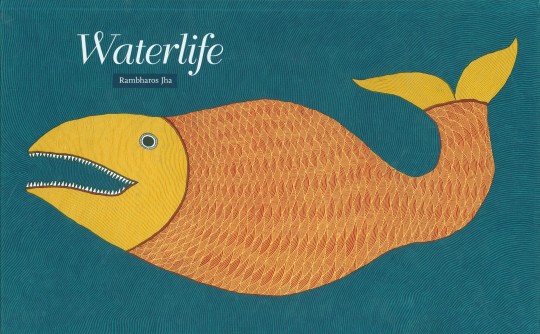



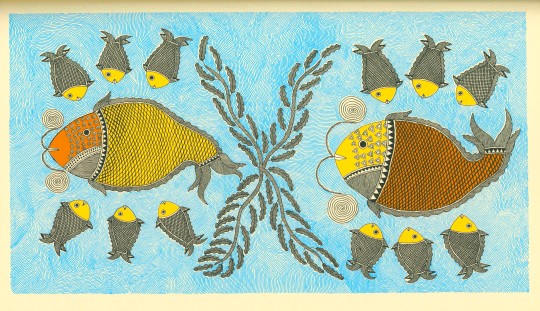
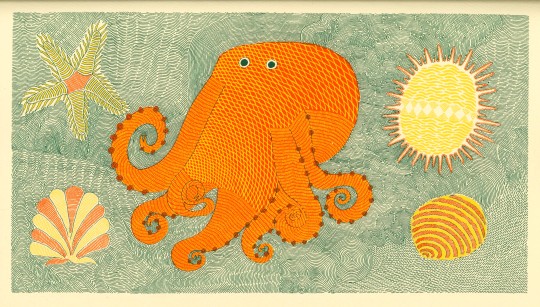
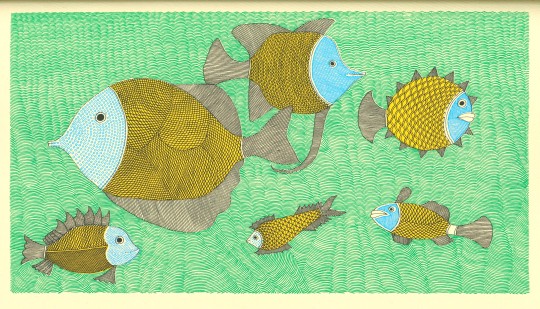
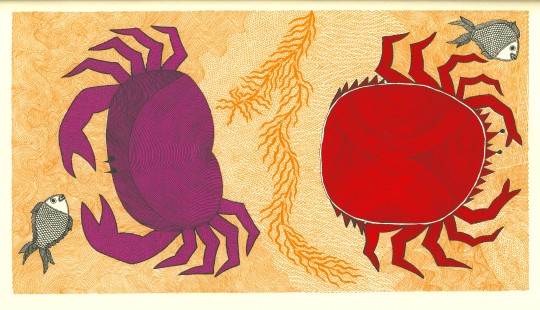
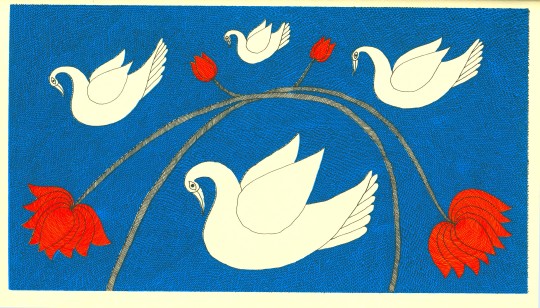
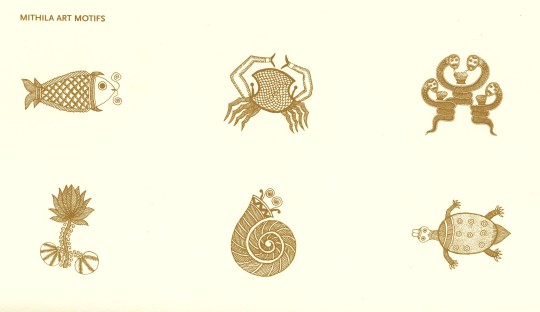
Growing up near the Ganga River in the cultural wellspring of Mithilia, Rambharos Jha spent much of his childhood observing the natural world and traditional arts of the region. When his father began working with a government project to breathe life into local art traditions, Rambharos had the opportunity to study Madhubani women painting walls and courtyards in their renowned Mithilia style utilizing natural dyes and pigments to depict people engaging with nature and deities.
Inspired by these encounters, Rambharos began his artistic painting career in line with the traditional motifs of Hindu mythology but has since evolved his practice to better represent his personal experiences and experimental mediums. Waterlife, published in 2012 by Tara Books, is a culmination of Rambharos’s efforts to balance the delicate traditions of Mithilia art with his contemporary ideas. Waterlife is silkscreen-printed by hand on handmade cotton paper and masterfully plays with adding movement and new subjects and environments to the classic Mithilia medium marrying Rambharos’s childhood memories and folk legends.
View more Staff Picks here.
-Jenna, Special Collections Graduate Intern
#Staff Pick of the Week#rambharos jha#waterlife#tara books#mithilia art#screenprinting#handmade paper#staff pick#silkscreen#Indian art#Madhubani India#Jenna#artists books
151 notes
·
View notes
Text



Rambharos Jha illustrates “Waterlife” with all its marine creatures based on Indian folk tales. Published by Tara Books in India.
Jha writes: "I was born in the culture-rich district of Darbanga, in the Mithila region. But my father moved along with all of us to Madhubani, where he started work in a government-supported art and cultural project. This project sought to breathe new life into local art traditions and also to help artists earn a living. Since women had traditionally decorated walls and courtyards, they participated in this project in large numbers…
Living as we did in Madhubani, I had a chance to look at what they were painting. I would spend hours watching them work. I had not known of this art earlier and wondered why I was drawn to it, and what purpose there could be in my being attracted to these lines and shapes? Mixing colours and ideas, the women drew pictures that took hold of my mind."
34 notes
·
View notes
Text
Rhythms of Mithila: The Spirit of Madhubani Art
Madhubani art, also known as Mithila painting, is one of the most celebrated forms of traditional Indian folk art. Originating from the Mithila region, which spans parts of Bihar, India, and Nepal, this art form is renowned for its unique style, intricate detailing, and vibrant use of colors. The name "Madhubani" translates to "forest of honey," which reflects the rich cultural and natural environment that inspires these artworks.
Historical Background
The origins of Madhubani art are deeply rooted in Indian mythology and history. It is believed that this art form dates to the time of the Ramayana, an ancient Indian epic. According to legend, King Janak of Mithila commissioned artists to create paintings on his daughter Sita's wedding to Lord Rama. This royal patronage helped establish the tradition of creating auspicious images to mark special occasions, a practice that continues to this day.
Traditionally, Madhubani paintings were made on the walls of homes during festivals, rituals, and important life events such as weddings and births. These paintings served as an expression of devotion, a means of preserving cultural narratives, and a way of bringing good fortune. Over time, the medium expanded from walls to cloth, paper, and canvas, making the art more accessible and portable.
Techniques and Materials*
Tools and Materials:
Madhubani art is characterized by its use of simple tools and natural materials. Artists traditionally use fingers, twigs, brushes, matchsticks, and even nib pens to create intricate designs. The natural pigments and dyes used in these paintings are derived from a variety of sources. For instance, yellow is obtained from turmeric, blue from indigo, red from the Kusum flower or red sandalwood, green from leaves, and black from burnt rice. Cow dung and mud are often mixed to prepare the base of the wall paintings, providing a natural texture and background.
Techniques:
The technique involves outlining the designs with bold lines using a mixture of cow dung and mud or black from burnt rice husk. This is followed by filling the spaces with bright, vibrant colors. The paintings often feature a double line border filled with intricate patterns and motifs such as flowers, animals, and geometric shapes. The figures in the paintings are typically depicted in profile, and the faces are drawn with elongated eyes, which is a distinctive feature of this art form.
Madhubani art does not leave any empty space in the composition; every inch is filled with intricate patterns and symbols. This technique of filling the entire space is known as Kachani or Bharni.The detailing and the use of geometric patterns are not just aesthetic choices but also hold cultural and symbolic meanings, reflecting the artists' connection to their cultural heritage.
Styles of Madhubani Art
Madhubani art is not monolithic; it encompasses several distinct styles, each with its own characteristics and thematic focus. The primary styles include:
Kachani Style:
Kachani style of Madhubani painting is style which comes from the Kayastha community by its intricate line work and fine detailing. Kachani is primarily monochromatic, using a minimal palette with black and white being predominant. This style focuses more on the detailing of the figures and the use of fine lines to create patterns. It often represents scenes from nature and daily life.

2. Bharni Style:
The Bharni style is known for its bold, vibrant use of colors and the depiction of mythological figures, nature, and animals. Traditionally practiced by Brahmin women, this style often portrays Hindu deities like Krishna, Rama, Durga, and Saraswati. The emphasis is on filling the central subject with solid colors, while the background may be decorated with intricate patterns.

3. Tantrik Style:
The Tantrik style is heavily influenced by tantric symbolism and motifs. It involves the depiction of tantric deities and yantras (geometric diagrams used in worship). This style is spiritual and esoteric, often featuring complex and abstract patterns that are rich in symbolic meaning.

4. Godna Style:
The Godna style is inspired by traditional tattoo patterns. This style incorporates symbols and motifs that are culturally significant and often linked to social beliefs and practices. It is characterized using repetitive patterns and motifs such as flowers, animals, and geometric shapes.

5. Kohbar Style:
The Kohbar style is specifically associated with marriage rituals. These paintings are created on the walls of the nuptial chamber and depict themes related to love, fertility, and prosperity. The central motif often includes a lotus flower, symbolic of fertility, surrounded by fish, birds, and other auspicious symbols.

Themes and Motifs
Madhubani paintings are rich in symbolism and cultural narratives. The themes can vary widely, but they often revolve around mythology, nature, and everyday life. Common motifs include:
- Mythological Figures: Depictions of Hindu gods and goddesses, such as Lord Krishna with Radha, Lord Rama with Sita, and various forms of the goddess Durga, are prevalent. These figures are often portrayed in vibrant, dynamic compositions that narrate stories from Indian epics and scriptures.
- Nature and Animals: The natural world is a significant inspiration in Madhubani art. Trees, flowers, birds, and animals like elephants, peacocks, and fish are commonly featured. These elements are not just enhancing but are also infused with cultural and spiritual symbolism. For example, the fish symbolizes fertility and prosperity, while the peacock represents beauty and love.
- Social and Cultural Practices: Madhubani art also captures scenes from daily life, such as agricultural activities, festivals, and social gatherings. These depictions provide a glimpse into the cultural practices and traditions of the Mithila region.
- Abstract and Symbolic Patterns: Geometric patterns, tantric symbols, and abstract designs are also a part of Madhubani art. These elements often carry deeper meanings and are used to convey philosophical and spiritual concepts.
Cultural Significance
Madhubani art is not just an artistic expression; it is a vital part of the cultural and social fabric of the Mithila region. The art form is deeply intertwined with the community's rituals, festivals, and social practices. For instance, the Kohbar paintings are an integral part of wedding ceremonies, symbolizing blessings for a happy and prosperous married life. Similarly, paintings of deities are created during festivals to invoke divine blessings.
The art form also serves as a medium for preserving and transmitting cultural knowledge and values. Through the depictions of mythological stories and traditional practices, Madhubani art helps keep the cultural heritage of the Mithila region alive.
Modern Adaptations and Global Recognition
In recent years, Madhubani art has acquired global appreciation and gratitude. The art form has transcended its traditional boundaries and found new expressions in contemporary contexts. Artists are now creating Madhubani-inspired designs on textiles, pottery, home decor items, and even fashion accessories. The use of modern materials and techniques has also expanded the scope of this art form.
The Indian government and various non-governmental organizations have played a crucial role in promoting Madhubani art. Initiatives such as exhibitions, workshops, and cultural exchange programs have helped bring Madhubani artists into the limelight. Additionally, the art form has found a place in international art markets, with collectors and art enthusiasts from around the world appreciating its unique aesthetic and cultural depth.
Economic and Social Impact
The commercialization of Madhubani art has provided a significant source of income for the artists, many of whom are women from rural backgrounds. This economic empowerment has had a positive impact on the community, enabling better access to education, healthcare, and other resources. Moreover, the recognition of Madhubani art on global platforms has instilled a sense of pride and cultural identity among the artists and their communities.
Challenges and Preservation Efforts
Despite its popularity, Madhubani art faces challenges, including the risk of losing traditional techniques and motifs to modernization. The younger generation's inclination towards urban life and modern professions has led to a decline in the number of traditional artists. Additionally, the influx of synthetic materials and commercialization has sometimes compromised the authenticity and quality of the artwork.
To address these challenges, several organizations and art enthusiasts are working towards preserving the traditional aspects of Madhubani art. Efforts include documentation of traditional techniques, promotion of natural dyes, and providing training and support to upcoming artists. Educational programs and workshops are also conducted to create awareness and appreciation for this art form among the younger generation.
Conclusion
Madhubani art is a timeless expression of cultural heritage, artistic excellence, and social narratives. It is a testament to the rich cultural tapestry of the Mithila region and an invaluable part of India's artistic legacy. As this art form continues to evolve and adapt to modern times, it retains its essence and continues to inspire and captivate audiences worldwide. The ongoing efforts to preserve and promote Madhubani art ensure that this beautiful tradition will continue to thrive and enrich the cultural landscape for generations to come.
2 notes
·
View notes
Note
Omggg Yes absolutely. He'd definitely be looking into art from his culture and be trying to mimic it, do his own take on it, and even try out traditional methods. Totally canon.
It gets better. If the components work together Krow could do a fusion.
'Fresco, the Italian word for fresh, is a form of mural painting in which earth pigments are painted directly on fresh, wet, lime plaster. As the plaster dries, a chemical process bonds the pigment and plaster together.'
"Kumkuma is a powder used for social and religious markings in India. It is made from turmeric or any other local materials. The turmeric is dried and powdered with a bit of slaked lime, which turns the rich yellow powder into a red color."
I have no idea whether this organic material is considered a mineral pigment after addition of the mineral lime, it is probably resistant to the strong alkali of the lime as that's used to change the colour, but I have no idea whether it would powder off.
However I bet Krow wonders, and is about to test all that with some turmeric that lost its flavour and leftover bags of lime pilfered from a building site. If he doesn't like it he can whitewash over it.
It's very useful for hiding or explaining recent plaster work. 😏
I also know the exact use for this medium for maximum cultural and personal significance... It is like madhubani painting but not quite.
Broooo I didn't know of this. This is super cool!
Yeah once Krow delves more into looking into his own culture's art and methods, I could see him coming across this, and doing some art experiments.
Krowspiracy be teaching me (and my other viewers with answering this ask lol) some things.
Probably in general he does often recycle stuff into pigment if he can't get another use out of it. I do remember having a class where we needed to make an art piece derived wholly from pigments we could make from stuff we found at home. My not being well versed in how to do it, nor having much stuff I could scrounge up, it was not an amazing painting lmao.
But yes. This all is very on brand for Krow.
14 notes
·
View notes
Link
From the ghats of Banaras to the morning weddings of Tamilians, modern painting bedroom, large painting bedroom, drawing room interior design, drawing room interior design ideas, small drawing room interior design and drawing room interior decoration, best drawing room interior design there is so much to be seen from our motherland. But you know what can help us visit these places without actually being there? https://www.theartlifegallery.com/blog/traditional-madhubani-painting-art-a-dive-into-an-indian-folk-art-painting
0 notes
Text
Day 9
Madhubani Art
"Madhubani Unique Magical Patterns: Discover the Stories Behind the Strokes"
"Delve into the folklore and symbolism woven into every brushstroke of Madhubani paintings. Join us as we decode the rich narratives and cultural heritage behind this captivating art form."
" What are the 3 themes in Madhubani's painting?
There are three main themes in Madhubani art: religion, social scenes, and elements of nature.
Religion: Hindu mythological figures and scenes from sacred texts are very common subjects, featuring popular deities like Radha and Krishna, Shiva, Ganesha, Saraswati and Laxmi.
Social: From harvests and markets to the royal court and children playing, Madhubani paintings beautifully render scenes from daily rural Indian life. Wedding ceremonies are especially sought-after, with messages of love and fertility.
Nature: The beauty and abundance of nature is an essential value of Madhubani paintings. Some of the most beloved images are the sun, the moon, birds and animals, the sacred Tulsi plant and Banyan trees."
Thank you for watching
Please like, comment and share for more.
#madhubanipainting #madhubani #madhubaniart #madurai #mithilapainting #mithila #mithilaart #arttherapy #artworld #artsy #artistoninstagram #artist #artlover #easydrawing #arttutorial #traditionalart #indianart #indianartform #indianartist
#introverted kour#aesthetic#artist#my artwork#my art#madhubani art#madhubani painting#madhubani#mithila art#traditional art#traditional drawing#ancient art#indian art
1 note
·
View note
Text
https://shop.umsas.org.in/product/chanderi-saree-with-unstitched-blousecream/
This is a Madhubani Saree. This Saree is a rare combination of culture and tradition mixed with modernity. Comfort wear saree & can be worn in all seasons. This saree reflects the touch of the human hand, the sensibility and skill of the craftsman thus making every piece unique. Look ethnic and traditional by draping into this party wear saree. This Madhubani hand-painted pure Chanderi saree is elegantly beautified with fancy print work that gives a ravishing look to the attire. The trendy and vibrant color combination makes it a perfect

2 notes
·
View notes
Text
Design Painting Works near Shankarpally
Home Decode : Home-Decode - Home Painting works near Shankarpally Hyderabad. Matte finish, Textured Painting, Satin paint finishing, Eggshell designer painting Works near ibrampatnam, Semi-gloss or High-gloss finish painting near Shankarpally . Customised colours Works Center near Shankarpally and accurate painting with best prices in ibramhimpatnam Hyderabad. India is a land of vibrant colors and diverse cultures. The country is known for its beautiful handicrafts, art, and paintings. Home wall paintings are one of the most popular art forms in India, Design Painting Works near Shankarpally which have been practiced for centuries. These paintings not only add a touch of elegance to the walls of homes but also reflect the rich cultural heritage of the country. Indian home wall paintings are available in various styles and designs. Some of the most popular styles include Madhubani, Warli, Rajasthani, and Tanjore. Each style has its unique characteristics, which make it stand out from the others. Madhubani paintings Works near Shankarpally originated in the Mithila region of Bihar and are known for their bright colors and intricate designs. The paintings often depict nature, animals, and Hindu deities. Warli paintings, on the other hand, Wall Painting Design Bed Room near Mokila originated in Maharashtra and are known for their simple designs, which often depict scenes from daily life. Rajasthani paintings Works near Rajasthani Painting Works near Mokila Shankarpally are known for their bold and vibrant colors, which are used to depict the royal lifestyle of Rajasthan. The paintings often depict kings, queens, and their palaces. Tanjore paintings originated in Tamil Nadu and are known for their intricate gold foil work. These paintings often depict Hindu deities and are considered as sacred art in many house H. Most Popular Painting Works near Shankarpally Indian home wall paintings are created using a variety of materials such aatural dyes, vegetable colors, and acrylic paints. Rajas The paintings are created on a variety of surfaces such as cloth, paper, and canvas. Textured Painting Works near Shankarpally Traditional Indian home wall paintings are often created using natural dyes and vegetable colors, Warli Painting Works Center near Mokila Shankarpally which are eco-friendly and non-toxic. In recent years, there has been a revival of interest in traditional Indian home wall paintings. Many artists are now using traditional techniques and materials to create modern interpretations of these paintings. Design Painting Works near Mokila These modern interpretations are often bold and vibrant, Warli Painting Works near Shankarpally with a contemporary twist. Indian home wall paintings are not only beautiful but also have cultural significance. They reflect the rich cultural heritage of the country and are often used to decorate homes during festivals and celebrations. Painting Design Works near Shankarpally They are also considered as a form of expression and are used to convey ideas, emotions, and beliefs.
All you need to paint is a few tools, a little instruction, and a vision in your mind:
Indian Home Painting Style Colors Works near Mokila SShankarpally home wall paintings are a beautiful and important art form. They reflect the rich cultural heritage of the country and are a form of expression. With their bold colors and intricate designs, these paintings add a touch of elegance to the walls of homes and are a testament to India's artistic legacy.
29 notes
·
View notes
Text
The Evolution of Madhubani Art Over Time
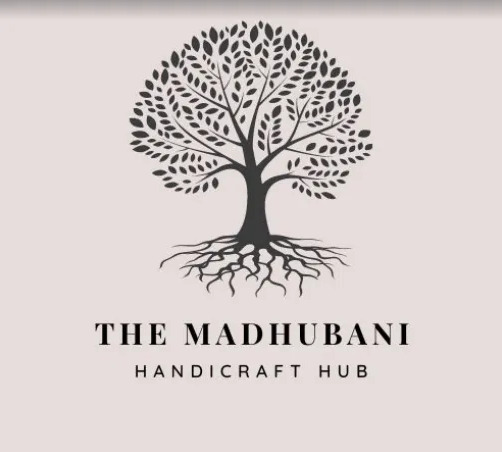
Madhubani art (also Mithila art) is a style of painting practiced in the Mithila region of India and Nepal. It is named after the Madhubani district of Bihar, India, which is where it originated. Artists create these paintings using a variety of mediums, including their own fingers, or twigs, brushes, nib-pens, and matchstick. The paint is created using natural dyes and pigments. The paintings are characterized by their eye-catching geometrical patterns. There is ritual content for particular occasions, such as birth or marriage, and festivals, such as Holi, Surya Shasti, Kali Puja, Upanayana, and Durga Puja.
Madhubani painting (or Mithila painting) was traditionally created by the women of various communities in the Mithila region of the Indian subcontinent. It originated from Madhubani district of the Mithila region of Bihar. Madhubani is also a major export center of these paintings.
This painting as a form of wall art was practiced widely throughout the region; the more recent development of painting on paper and canvas mainly originated among the villages around Madhubani, and it is these latter developments that led to the term “Madhubani art” being used alongside “Mithila Painting.”
Mithila paintings mostly depict people and their association with nature and scenes and deities from the ancient epics. Natural objects like the sun, the moon, and religious plants like tulsi are also widely painted, along with scenes from the royal court and social events like weddings. In this paintings generally, no space is left empty; the gaps are filled by paintings of flowers, animals, birds, and even geometric designs.[citation needed] Traditionally, painting was one of the skills that was passed down from generation to generation in the families of the Mithila Region, mainly by women .
It is still practiced and kept alive in institutions spread across the Mithila region. Asha Jha of Madhubanipaints in Darbhanga,
Vaidehi in Madhubani, Benipatti in Madhubani district and Gram Vikas Parishad in Ranti are some of the major centres of Madhubani painting which have kept this ancient art form alive.
Contributions:
The Madhubani painting tradition played a key role in the conservation efforts in India in 2012, where there was frequent deforestation in the state of Bihar. Shashthi Nath Jha, who runs the Gram Vikas Parishad, an NGO, started the initiative as an attempt to protect local trees that were being cut down in the name of expanding roads and development. The main reason behind this was that the trees were traditionally adorned with forms of gods and other religious and spiritual images such as those of Radha-Krishna, Rama-Sita, scenes from Ramayana and Mahabharata and other mythologies.
Darbhanga MP Gopal Jee Thakur started the tradition of honouring people with Mithila Painting in Indian Politics.
Awards:
Madhubani painting received official recognition in 1969 when Sita Devi received the State award by Government of Bihar. Mamta Devi from the village Jitwarpur has also got National Award. Jagdamba Devi from Bhajparaul, Madhubani was given Padma Shri in 1975 and the National Award to Sita Devi of Jitwarpur village near Madhubani.
Jagdamba Devi’s foster son Satya Narayan Lal Karn and his wife Moti Karn are also well-regarded Mithila artists, and they won the National Award jointly in 2003. Sita Devi received the Padma Shri in 1981. Sita Devi was also awarded by Bihar Ratna in 1984 and Shilp Guru in 2006.
In 1984 Ganga Devi was awarded by Padma Shri. Mahasundari Devi received the Padma Shri in 2011. Baua Devi, Yamuna Devi, Shanti Devi, Chano Devi, Bindeshwari Devi, Chandrakala Devi, Shashi kala Devi, Leela Devi, Godavari Dutta, Asha Jha and Bharti Dayal were also given the National award.
Chandrabhushan (Rasidpur), Ambika Devi (Rasidpur), Manisha Jha were also given the National award.[citation needed] In 2020, Madhubani artist Dulari Devi won the Padma Shri for contributions to art.
Styles:
Mithila art has five distinctive styles:
Bharni
Katchni
Tantrik
Godna
Kohbar
In the 1960s Bharni, and Tantrik styles were mainly done by Brahman women in India and Nepal. Their themes were mainly religious and they depicted Gods and Goddesses paintings. People of other castes included aspects of their daily life and symbols, the story of Raja Shailesh (guard of the village) and much more, in their paintings. Nowadays Madhubani art has become a globalised art form, so there is no difference in the work on the basis of the caste system. They work in all five styles. Mithila art has received worldwide attention.
The paintings were traditionally done on freshly plastered mud walls and floors of huts, but now they are also done on cloth, handmade paper and canvas.
Madhubani paintings are made from the paste of powdered rice. Madhubani painting has remained confined to a compact geographical area and the skills have been passed on through centuries, the content and the style have largely remained the same. Thus, Madhubani painting has received GI (Geographical Indication) status. Madhubani paintings use two-dimensional imagery, and the colors used are derived from plants. Ochre, Lampblack and Red are used for reddish-brown and black, respectively.
For more info visit our Website — https://madhubniart.com/
Best Madhubani art near me, Cheapest Madhubani art, Cheapest Madhubani art near me, Madhubani art gallery, madhubani art history, Madhubani art information, madhubani art about, madhubani art book, madhubani art types, Madhubani Art Pen Holder, Madhubani Art Beautiful Jar, Madhubani Art Bowl, Madhubani Art Ceramic Mugs
8 notes
·
View notes
Text
Mithila's Treasures: Madhubani Paintings as Cultural Heritage
Madhubani paintings, also known as Mithila paintings as the name implies, are paintings done by the people of the Madhubani district in Bihar. They are named after the place where they originated. These paintings are often made using natural dyes and are usually done with fingers, twigs, brushes, and matchsticks. Eye-catching geometric designs and patterns can be noticed in these paintings, often accompanied by religious symbols and symbols of nature. In this blog, we will discuss the origins of these paintings, the materials used, the process of making these paintings, the important role of women in making these paintings, and how they are used as cultural heritage.

The Origin of Mithila Art
The history of Mithila art can be traced back about 2500 years ago to the Mithila region when Kind Janak requested an artisan to paint a representation of his daughter’s wedding to Prince Rama. Janak was very happy with the painting and since then people used to draw Mithila paintings on the walls of their homes on every happy or auspicious occasion. These paintings often depict the events of the Ramayana, daily life, and local folklore. In the middle of the 20th century, Madhubani art became known outside of the Mithila territory. In 1934, an earthquake hit Bihar and caused a lot of damage. A British colonial officer named William G. Archer saw beautiful artwork on the walls of houses that had been destroyed by the earthquake. Archer was amazed by how beautiful these paintings were, so he chose to take pictures of them and share them with the rest of the world.
How Madhubani Paintings Are Made: The Materials Used
Natural dyes and pigments are used in crafting the paintings. The colors and dyes are sourced from natural sources such as flowers, leaves, roots, minerals, and other organic substances. The most common colors used are black, red, yellow, green, and blue, all of which are earthy colors. The artisans use their fingers, twigs, brushes, and other tools to make intricate patterns and geometric shapes. The use of natural materials depicts the connection of Traditional Mithila Arts to nature and the environment. The unique texture and vivid colors of the paintings are the result of the artisans' hard work using natural dyes and pigments. Traditionally, natural materials were used to make these paintings on the walls and floors of houses. But as time went on and people wanted to keep this art form alive, artists began to use new tools. They started painting in the Madhubani style on paper and canvas, which made it easy to show off their work and sell it.
Important Role of Women in Madhuban Art
Women play a significant role in the Madhubani or Mithila paintings as the art form was traditionally passed down through generations from mothers to their daughters. The daughters kept on adding their own creative touches and representations to the paintings, which made it a unique art form. The women of the Mithila region were the curators of the art form, and the creative talent and skill of those women made these paintings a source of empowerment and recognition. In today's world, women have transformed the art of Madhubani painting into a source of income and a means of empowerment. Not only has the art of Madhubani given women a medium through which they may express themselves, but it has also given them the opportunity to be financially independent.
Madhubani, an Art Form Dedicated to Story-Telling
The Mithila paintings are an art form that is exclusively dedicated to storytelling. Scenes from Hindu mythology, local folklore, and everyday life are often depicted in traditional Madhubani paintings. Each one of the paintings tells a narrative, conveys a specific message, or serves a particular purpose. The art form and stories are deeply rooted in the culture and traditions of the Mithila region and are passed down from generation to generation. The passage of the art form from one generation plays an important role in preserving the cultural heritage of the region.
Paintings in the Madhubani style are more than just works of art; they represent the very essence of a flourishing cultural tradition. They are the expressions of the women in a community as well as the colors of the customs that have been passed down. At the same time as we honor and appreciate the art of Mithila, we are aware of the significance of protecting and promoting such artistic treasures for the future generations of our society. These paintings are a living testimony to the devotion of Mithila's spirit, and despite the passage of time, their eternal beauty and fascinating narratives never fail to enchant audiences.
4 notes
·
View notes
Text
Healing with Mandala Art Therapy
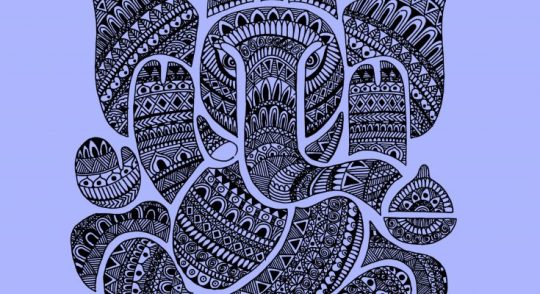
Mandala is the Sanskrit for Circle or Completion, where one makes mandala a window for self-examination inside. Mandala art is a vessel for allowing thought, and the process of creation is a form of meditation Exercises that relieve stress are quick and easy to do and can be used as a focus for continuous meditation. The mandala is a symbol of the universe and gives us the feeling of being part of it as we have it. Our internal communication and is used for understanding, healing, and self-expression in circular structures, reflecting the wholeness of the person creating it.
Nature creating the mandala is a healing and symbolic way. The shapes and colors you create in your MandalaArt will show your inner identity at the time of creation. Your natural state and attitude should encourage and guide you through the creative process. Eventually, you will be creating your own image just as you are when you create a mandala.
Therefore, whatever you feel at that moment, whatever feelings come your way, will be represented in your mandala art therapy. Like most art therapies, it’s not about the final product… it’s about the journey. When you get to your destination, you will have a representation of something that makes sense to you and your image for a short time in the time expressed by your mandala.
Mandala are sacred pieces of art used to awaken healing, spiritual growth and meditation.The word Mandala means 'sacred circle' and is derived from the word 'mandra' which means 'vessel of greatness'. This circle or 'vessel of the essence' is said to represent perfection, health, communication, unity, harmony and life cycle. It is also said to symbolize unity with life.
Mandala also contains geometric patterns that reflect and represent Global Geometry. They usually have a focal point in the center known as the seed and the beginning of the construction of Mandala and all life.
The traditional Buddhist Mandala includes four quadrants that are said to represent loving-kindness, compassion, compassion and equality.These quadrants are also decorated with colors - white, yellow, red, green and blue which are said to cure the soul.
White: Heals ignorance and transforms it into acceptance, purity and wisdom.
Yellow: Heals pride and transforms it into unity, compassion and abundance.
Red: Heals attachment and fear and turns it into confidence, freedom and power.
Green: Heals jealousy and transforms it into unconditional love, understanding and accomplishment.
Blue: Heals anger and transforms it into your sign, your self-expression, and your sense of humor.
Coloring your Mandala, using whatever medium you desire such as paints, crayons, watercolors etc. Focus on your intention and remain open to the healing you may receive.
Penkraft conducts classes, course, online courses, live courses, workshops, teachers' training & online teachers' training in Handwriting Improvement, Calligraphy, Abacus Maths, Vedic Maths, Phonics and various Craft & Artforms - Madhubani, Mandala, Warli, Gond, Lippan Art, Kalighat, Kalamkari, Pichwai, Cheriyal, Kerala Mural, Pattachitra, Tanjore Painting, One Stroke Painting, Decoupage, Image Transfer, Resin Art, Fluid Art, Alcohol Ink Art, Pop Art, Knife Painting, Scandinavian Art, Water Colors, Coffee Painting, Pencil Shading, Resin Art Advanced etc. at pan-India locations. With our mission to inspire, educate, empower & uplift people through our endeavours, we have trained & operationally supported (and continue to support) 1500+ home-makers to become Penkraft Certified Teachers? in various disciplines.
2 notes
·
View notes